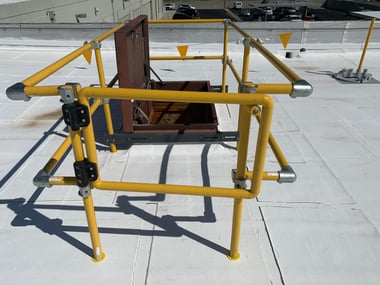Roof hatches provide essential access to rooftops for maintenance, repairs, and inspections;...
What to Know about Roof Hatch Safety Railing Systems
Roof hatches provide essential access to rooftops for maintenance, repairs, and inspections; however, these convenient portals pose a significant safety risk if not adequately surrounded by a roof hatch safety railing system. Falls from roofs are a leading cause of workplace injuries and fatalities, making safety railing systems a crucial investment for any building owner or manager responsible for rooftop safety. This includes protecting the perimeter or edge of the roof as well as openings on the roof itself such as hatches and stairways.
Rooftop Safety: A Top Priority
Before diving into the specifics of roof hatch safety railings, let's establish the importance of rooftop hazards in general. Working at heights inherently carries risks, and rooftops are no exception. Slips, trips, falls, and exposure to extreme weather conditions are just some of the dangers workers face when accessing and working on roofs.
To mitigate these risks and create a safe working environment, regulations like OSHA 29 CFR 1910.28 mandate specific fall protection measures for employers to implement. This includes the use of proper personal protective equipment (PPE) and the installation of fall protection systems like guardrails around roof hatches.
Understanding Roof Hatch Safety Railing Systems
These systems act as physical barriers preventing falls from open roof hatches. They come in various types, each offering unique advantages and considerations.
Types of Roof Hatch Safety Railing Systems:
Fixed railing systems: Permanently mounted to the roof hatch curb, these systems tend to be sturdy and long-lasting. However, penetrating railing systems require anchoring into the roof structure, which has the potential to cause damage.
Portable railing systems: Lightweight and easy to move, these are ideal for occasional or temporary rooftop access, but may also be used longer term. These are typically non-penetrating solutions.
Fibergrate’s non-penetrating railing systems offer the benefits of both categories. They can be used on a temporary or permanent basis and are installed in a way that is highly stable but without harming the roof structure.
Materials Used in Roof Hatch Safety Railing
The materials used in safety railing construction play a vital role in their performance and longevity. Here are some common options:
Fiber Reinforced Polymer (FRP): Lightweight, corrosion-resistant, and strong, making it a top choice for rooftop applications. Easy to install and even modify in the field using handheld power tools.
Aluminum: Offers good strength and reasonable corrosion resistance, but is susceptible to dents and scratches.
Stainless steel: Durable and somewhat corrosion resistant, but heavier and more expensive to install than FRP or aluminum.
The Fibergrate Dynaround Hatch Guard
Among FRP safety railing systems, Fibergrate's Dynaround Hatch Guard stands out for its innovative design and exceptional features. This non-penetrating system easily clamps onto the hatch curb, requiring no roof penetrations that could compromise the roof's integrity.

Fibergrate's Dynaround Hatch Guard |
Benefits of the Dynaround Hatch Guard:
Easy installation and removal: No special tools or skills are required, making it ideal for both permanent and temporary use.
Lightweight and portable: Facilitates easy transport and storage.
High visibility: Bright yellow color for enhanced safety awareness.
Durable construction: FRP withstands harsh weather conditions and resists corrosion.
Compliance with safety standards: Meets OSHA and ANSI Z359.18-2017 fall protection requirements.
Installation and Maintenance of Roof Hatch Safety Rails
Proper installation and regular maintenance are key to ensuring the effectiveness of your roof hatch safety railing system. Always follow the manufacturer's instructions for a safe and secure setup. Regularly inspect the system for any signs of damage or wear and tear, and address any issues promptly.
Choosing the Right Roof Hatch Safety Railing
Selecting the ideal system requires carefully considering your needs and rooftop environment. Assess factors like the frequency of roof access, hatch size and type, budget, and desired level of portability. Consulting a qualified professional can help you make an informed decision.
While roof hatch safety railings are essential, they are just one piece of the puzzle when it comes to comprehensive rooftop safety. Additional measures like proper training for workers on fall prevention practices, the use of personal fall arrest systems, and the installation of guardrails around perimeter edges are crucial for creating a truly safe rooftop environment.
Conclusion
Investing in roof hatch protection is not just a regulatory requirement; it's an investment in the safety and well-being of your most valuable assets: your people. By prioritizing safety and implementing the right safeguards, you can ensure peace of mind knowing your rooftop access is secure, compliant, and ready for anything.
Don't wait for an accident to be your wake-up call, partner with Fibergrate today and experience the peace of mind brought by comprehensive rooftop protection.
Topics: Fiberglass, FRP, Safety, Employee Safety


